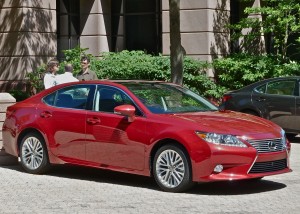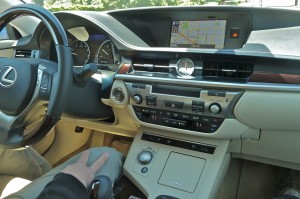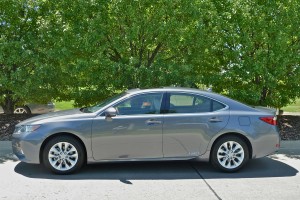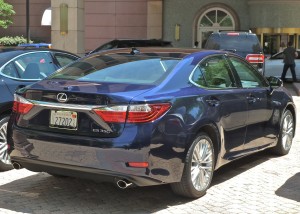Lexus adds luxury, and hybrid, to 2013 ES

New "spindle" grille sets off totally restyled 2013 Lexus ES sedans, consisting of the 350 and the 300h hybrid.
By John Gilbert
A couple of definitive terms come to mind after first examining the 2013 Lexus ES 350 — Low-key luxury, and quiet competence.
Therein lies the main asset of all things Lexus, and simultaneously what some critics might call the main liability. The beauty of almost all Lexus sedans or SUVs is that they fulfill all expectations rather than trying to set themselves apart with quirky design tricks. In an era when many companies are trying to find uniqueness in their styling, Lexus, and its parent Toyota, have stayed with the formula that has allowed them to strike it rich beyond reasonable bounds — building cars that satisfy, more than surprise.
When Lexus first brought out its luxury LS flagship, the company realized it needed something more of an entry-level attraction as well. The ES was born in 1989, and as one of the originators of what later became the “entry luxury” segment, the front-wheel-drive ES was pretty much a gussied-up Toyota Camry. Lexus officials, however, pointed out over 100 modifications that separated the ES above the garden-variety Camry, and collectively, they justified a larger price tag. The ES 250 was from 1989-91; the ES 300 was 1992-96; the ES 300 was joined by the ES 330 for the 2002-06 run; and the fifth generation was the ES 350 from 2007-12.
For 2013, it’s time for the sixth generation ES, and comes as both the ES 350 and ES 300H — its first hybrid. Chief designer was Toshio Asahi, who spent five years helping design the latest Lexus LS luxury flagship, so he applied a more luxurious look to the ES. The ES has smoothly flowing lines, with a decidedly sportier-looking front end. Lexus calls it a “spindle” grille, which is something of a modified hourglass shape, tapering from a wide upper opening to a narrower middle, then widening again below the bumper from the front fascia. It is similar to the look of the much more sporty and aggressive GS, and the LX SUV, and signals a signature look for future Lexuses (Lexi?).
The new ES is an inch longer with a two-inch longer wheelbase, and the steeply sloped “A” pillar at the front of the doors, as well as the underside, have been reworked for optimum aerodynamics. The ES has a coefficient of drag of only 0.27, where anything under 0.35 is impressive.
Lexus models have proliferated in the 24 years since the ES first came on the scene. The LS luxury flagship remains, with the ES joined by the high-economy CT 200h, and the sportier GS and IS, with “F-Sport” versions, which lend more sportiness to three different lines. The GS and ES are nearly the same size, but with the GS and IS are rear-wheel-drive — unless you choose the all-wheel-drive GS version — while the ES remains front-wheel drive, a definite benefit to consumers where winter weather can be challenging. A couple of SUVs round out the Lexus stable — including the RX, the popular crossover which is due for revision this summer.
As it has risen in sophistication, the ES is the top-selling car in the Lexus fleet, with 38,533 sold in 2011, a year when total Lexus sales were limited to 200,000 by the earthquake and accompanying tsunami that battered Japan in March of 2011, with projections for 2012 topping 250,000.
As if getting a reward, the ES gets a unique platform for 2013, although the upcoming Toyota Avalon will share the same underpinnings, meaning both cars that spun off as fancy and elongated versions of the Camry will now have their own platform. The new ES 350 price is expected to stay close to the current model’s $37,500 base sticker, so a good estimate is $40,000, with the hybrid costing a chunk more, and some lucrative options threatening to increase the investment.
Toyota, perhaps more than any other company in the world, is disciplined in following what its market research shows, and it’s difficult to fault the strategy, which led Toyota to the No. 1 spot in auto-making, and may well lead it back to that pinnacle now that production has returned to normal from the damaged factories and supply lines. Lexus officials say they expect to sell 50 percent of the cars in the U.S., with 30 percent going to China, and the remaining 20 percent to be shared by the rest of the world. Lexus also expects 25 percent of ES models to be the hybrid.
Lexus has hybrid versions of five different models now, and Tim Morrison, vice president of sales and dealer development said, “We want to have a hybrid in every line.”
The primary ES is the ES 350, which has a 3.5-liter V6, with 268 horsepower and 248 foot-pounds of torque. The dual overhead camshaft V6 propels the ES350 swiftly and surely, and attains a 31-miles-per-gallon highway EPA estimate on 87-octane regular fuel.
The hybrid is the 300h, which is the first hybrid in the ES line. It has a small, 2.5-liter V6, with a 1.6 killowatt-hour nickel-metal-hydride battery pack. In combination, the gas and electric power produces 200 horsepower, and can reach 40 mile per gallon.The system, similar to Toyota’s Hybrid Synergy Drive in the Prius, uses the gasoline engine to generate electricity, joining the battery pack to drive the car electrically while also recharging the battery pack. Like the Prius and other corporate hybrids, the gasoline engine will never move the vehicle by itself — instead creating electricity with which to turn the wheels.
Like the ES 350, the ES 300h moves swiftly, and the seamless power is always smooth. When the battery pack is fully charged, the ES 300h can be driven on only its battery power for 1.5 miles at speed up to 25 mph, a speed and distance that is common around town. Going beyond those meager limits is no problem, it just means the high-tech, Atkinson-cycle, dual overhead cam V6 will kick in to keep the electrical power up. Stepping hard on the gas elicits the same action.
Charles Hubbard, a spokesman from “Lexus College,” that corporate bastion to perfect Lexus-speak, explained that the corporate vehicles with plug-in hybrid technology have switched to lithium-ion battery packs, but the Panasonic-built nickel-metal-hydride system in the ES300h is built to last the life of the car.
To understand the hybrid system best, its power can be broken down to two motor/generators, called MG-1 and MG-2. The MG-1 motor/generator is connected to the gasoline V6 and acts primarily as a generator that handles starting and speed control. Meanwhile, MG-2 connects directly to the final drive and acts primarily as a motor, but also as a generator for regenerative braking, and is responsible for keeping the vehicle in electric-only mode longer at low speeds — up to 25 mph for up to a half mile.and if the The car’s battery pack and starter is powered by MG-1.
The hybrid powerplant’s improved smoothness has been achieved by a new inverter, which is smaller and lighter, and jacks the direct current power from 244 to 650 volts, then converts that electrical power to the alternating current that drives both MG-1 and MG-2, and takes care of elctric powre steering and the electric air-conditioning compressor. The good, old 12-volt battery is still there, but all it does is turn on the car’s powertrain and instruments.
The smooth exterior is complemented by an attractive and efficient interior, divided into a display zone, with information, and an operation zone, with controls on the center console.
From occupant standpoints, the new interior is comfortable and supportive, and drivers might notice that the steering wheel has been lowered from the current model, and it now has an option to be heated. The 10-way front power seats are more bolstered, and can be lowered an inch more as well, while rear legroom and headroom are improved by an inch or two. An electronic rear sunshade can be raised or lowered at the touch of a switch, and there are manual pull-up rear side-window shades as well. A smart-key allows keyless entry and push-button start, and if you and your spouse both have keys, each will have memory capability to remember your specific seat position, steering wheel tilt, climate control settings, and mirror angles. A nice touch, if you both drive.
The car’s steering and smooth handling are enhanced to a fine balance between ride comfort and stable handling. The steering gear has been quickened, from a 15 to 1 ratio to 14 to 1, and the body, which is built out of significantly more high-grade steel for added rigidity, gains stability from a unique “opposite wound” coil spring design, which, as the spring flexes, results in both coils pulling toward the center.
Such features as lane-departure alert, automatic high beams, and an indicator of any tire going low and its inflation pressure, are impressive, if not unique. An ambient light strip that encircles the doors and dashboard are a nice, luxurious touch that doubtlessly will also find its way into other Lexus models. The connectivity plays through a 7-inch screen, which can be increased to an optional 8-inches for those who want to see their navigation system’s map nearer to life-size.
One of my favorite features is a switch that offers Normal, Eco, or Sport modes, and it’s on both the ES 350 and the ES 300 hybrid. The Sport setting quickens the steering and gives more mid-range acceleration for more aggressive response. Eco mode does the opposite, reducing throttle response and modifying the air-conditioning to maximize fuel savings. Normal mode balances those extremes for most driving and fuel efficiency.
The standard audio system is very good, too, and you can upgrade to an 835-watt, 15-speaker Mark Levinson optional sound system that might threaten to blow out the new acoustic glass in the windows if you tried to use all that woofering.
The ES 350 interior features bird’s-eye maple with its leather upholstery, while the ES 300h has a light, bamboo wood trim. That may seem low-key, but it fits the ES 350 and ES 300h mold — low-key luxury, and definitely more than just quiet competence.
Comments
Tell me what you're thinking...
and oh, if you want a pic to show with your comment, go get a gravatar!






 John Gilbert is a lifetime Minnesotan and career journalist, specializing in cars and sports during and since spending 30 years at the Minneapolis Tribune, now the Star Tribune. More recently, he has continued translating the high-tech world of autos and sharing his passionate insights as a freelance writer/photographer/broadcaster. A member of the prestigious North American Car and Truck of the Year jury since 1993. John can be heard Monday-Friday from 9-11am on 610 KDAL(www.kdal610.com) on the "John Gilbert Show," and writes a column in the Duluth Reader.
John Gilbert is a lifetime Minnesotan and career journalist, specializing in cars and sports during and since spending 30 years at the Minneapolis Tribune, now the Star Tribune. More recently, he has continued translating the high-tech world of autos and sharing his passionate insights as a freelance writer/photographer/broadcaster. A member of the prestigious North American Car and Truck of the Year jury since 1993. John can be heard Monday-Friday from 9-11am on 610 KDAL(www.kdal610.com) on the "John Gilbert Show," and writes a column in the Duluth Reader.